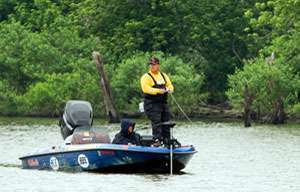
It's the best of times; it's the worst of times. The fishing's easy; the fishing's hard. Bass are everywhere; bass are nowhere to be found. In a nutshell, that describes the ups and downs of fall fishing for many of us. It's feast or famine out there, and the stretches between feasts can be discouraging.
But Elite Series pro Elton Luce has a plan for fall bass that has served him well over the years and that will work for you — especially if your favorite water has some aquatic vegetation.
As the water cools and the bass start moving into the creeks, I like to go to the mid-sections of the creeks that have some vegetation," Luce says. "The bass will congregate around hydrilla, lily pads or other weeds and gorge themselves in preparation for winter."
Luce relies on this pattern once the water temperature drops into the mid-60s. When it does, you'll find him near the vegetation and tossing one of two baits.
"My go-to baits for this pattern are a 5-inch Berkley Sinking Minnow in watermelon with red flake or junebug and a 3/8-ounce spinnerbait in chartreuse and white with double willowleaf blades (gold). I've found that with these two lures I can cover a wide variety of weather and water conditions in the fall as well as catch numbers and some big bass, too."
For numbers, Luce likes the Sinking Minnow. It's a big part of his arsenal all year long, but he has a special way of fishing it in the fall that's particularly effective.
"I like to deadstick it," he says, referring to the technique of leaving a bait idle for long periods. "I'll cast it out to a good looking spot in the vegetation, like a hole or point, and let it settle slowly to the bottom. On a calm day, I'll let it sit there until the splash has dissipated before I start to move it."
Sixty to 70 percent of Luce's strikes come on the initial fall — between the time the bait first hits the water and when it touches bottom. If the Sinking Minnow manages to get all the way to the bottom, Luce leaves it there for at least five or six seconds as the splash rings settle out. Only then does he move it… slowly.
"I crawl it very slowly across the bottom," he says. "I want it to look like it's nearly dead — an easy meal. It should look like something that's fallen off a tree limb or out of a bird's grasp when it hits the water. As it falls, that Sinking Minnow has a death quiver to it that triggers strikes. I want it to look just as vulnerable as it crawls along the bottom."
For his Sinking Minnow fishing, Luce opts for a 7-foot medium-heavy Fenwick Techna AV casting rod and an Abu Garcia Revo STX with a 7:1 gear ratio. He likes Berkley Trilene 100% fluorocarbon line and a 4/0 wide gap, round bend hook from Academy Sports + Outdoors.
His other technique for catching transition bass from the vegetation involves a 3/8-ounce spinnerbait in chartreuse and white. His favorite model sports gold double willowleaf blades. And, just like with the stickworm, Luce fishes the spinnerbait slowly.
"Slow rolling has been the most effective retrieve for me in the early fall," he explains. "I'll work it around stumps and logs in addition to the vegetation and get most of my strikes when the bait is bumping into something.
"Bumping the spinnerbait into the vegetation is best. When you get it just right, it makes the blades clink together or against the wire frame. Once you hit the vegetation, give your rod tip a sharp snap to get the blades moving again and to pull any weeds off the lure. That little jump will often trigger a reaction strike from any bass that are nearby."
Slow rolling is also a favorite tactic for Luce when a cold front has just passed.
"We get a lot of fronts at this time of year," he says, "and most guys will go to a finesse presentation, but I can still get bites on the spinnerbait by slow rolling it around the outside edge of the vegetation.
"Even if the water temperature has dropped 6 or 7 degrees overnight, some bass holding on that outside weed edge will hit a spinnerbait if it comes by them nice and slow."




